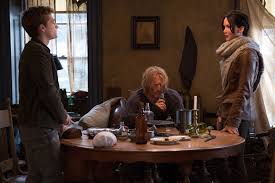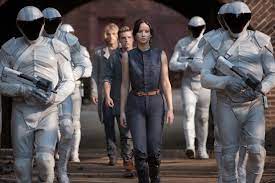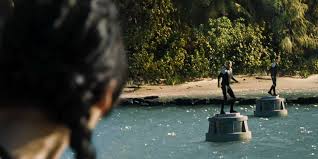🎬 The Hunger Games: Catching Fire (2013)

“The Hunger Games: Catching Fire” (2013): A Masterclass in Elevated Stakes and Emotional Depth
https://www.youtube.com/watch?v=EAzGXqJSDJ8
When The Hunger Games debuted in 2012, it introduced audiences to a dystopian world rife with political oppression, economic disparity, and deadly spectacle. The franchise’s second installment, The Hunger Games: Catching Fire (2013), directed by Francis Lawrence, not only lives up to its predecessor but surpasses it, delivering a film that raises the stakes, deepens the emotional core, and expands the scope of Suzanne Collins’ beloved series.
Plot Summary
Catching Fire picks up where the first film left off. Katniss Everdeen (Jennifer Lawrence) and Peeta Mellark (Josh Hutcherson) return to District 12 as the victors of the 74th Hunger Games. Their victory has made them symbols of hope for the oppressed citizens of Panem, much to the chagrin of President Snow (Donald Sutherland). Snow warns Katniss that her defiance in the Games has sparked rebellion, and he expects her to quell the unrest by continuing the façade of her love for Peeta during the upcoming Victory Tour.
However, as the districts stir with revolution, the Capitol announces a shocking twist for the 75th Hunger Games—known as the Quarter Quell. Former victors will be reaped as tributes, forcing Katniss and Peeta back into the arena. This time, the stakes are even higher, with seasoned killers, shifting alliances, and the ever-present threat of Snow’s manipulation looming over them.
Themes of Rebellion and Oppression
The overarching theme of Catching Fire is rebellion. While the first film hinted at Panem’s unrest, this sequel places it at the forefront. Katniss, initially an unwilling participant in the Capitol’s power games, evolves into a reluctant symbol of resistance. Her journey reflects the struggles of oppressed individuals who, despite personal fears and desires, find themselves thrust into leadership roles they never sought.
The film also delves deeper into the Capitol’s oppressive control. Through scenes of public executions, Peacekeeper brutality, and Snow’s menacing presence, Catching Fire portrays the systemic violence that maintains Panem’s power structure. This dark portrayal of dystopia resonates strongly with contemporary audiences, serving as a chilling reminder of the consequences of unchecked power and inequality.
Katniss Everdeen: A Reluctant Hero
Jennifer Lawrence delivers a tour-de-force performance as Katniss Everdeen, capturing the character’s complexity with remarkable authenticity. Katniss is not a conventional hero; she is deeply flawed, struggling with survivor’s guilt, PTSD, and the weight of her symbolic status as the “Mockingjay.” Lawrence portrays these layers with raw emotion, making Katniss one of the most compelling protagonists in modern cinema.
Katniss’s relationships with those around her—particularly Peeta, Gale (Liam Hemsworth), and Haymitch (Woody Harrelson)—add depth to her character. Her bond with Peeta evolves from reluctant partnership to genuine camaraderie, highlighting their shared trauma and mutual dependence. Meanwhile, her complicated feelings for Gale underscore her internal conflict between personal desires and her duty to the rebellion.
Expanding the World of Panem
Catching Fire expands the world of Panem in significant ways, both geographically and politically. The Victory Tour offers a glimpse into the diverse districts, each with its own culture and struggles. These scenes emphasize the stark divide between the Capitol’s opulence and the districts’ suffering, creating a vivid contrast that underscores the story’s central themes.
The introduction of the Quarter Quell adds a new layer of intrigue. Unlike the first Hunger Games, which focused on survival in a brutal environment, this arena becomes a chessboard for alliances, manipulation, and strategic warfare. The tropical setting, with its deadly traps and timed disasters, is a brilliant departure from the forested arena of the first film, showcasing the Capitol’s cruelty and ingenuity.
The Supporting Cast: Alliances and Threats
Catching Fire introduces several new characters who enrich the story and bring fresh energy to the narrative.
- Finnick Odair (Sam Claflin): A former victor from District 4, Finnick is charming, enigmatic, and far more complex than he initially appears. Claflin captures Finnick’s charisma and hidden vulnerability, making him a standout addition to the series.
- Johanna Mason (Jena Malone): Johanna’s sharp wit, defiance, and unpredictable nature add a fiery dynamic to the story. Malone’s portrayal is electric, balancing humor and ferocity in equal measure.
- Plutarch Heavensbee (Philip Seymour Hoffman): As the new Head Gamemaker, Plutarch brings an air of subtle cunning to the film. Hoffman’s understated performance hints at Plutarch’s true loyalties, adding layers of intrigue to his character.
Returning cast members also shine:
- Josh Hutcherson continues to imbue Peeta with quiet strength and unwavering loyalty, creating a poignant counterbalance to Katniss’s fiery independence.
- Woody Harrelson’s Haymitch remains a scene-stealer, blending sardonic humor with genuine pathos as he mentors Katniss and Peeta through another life-or-death ordeal.

Action and Suspense: Raising the Stakes
The action sequences in Catching Fire are meticulously crafted, blending visceral intensity with psychological tension. The Quarter Quell arena is not just a battleground but a meticulously designed death trap, featuring poisonous fog, blood rain, and lethal monkeys. These challenges push the tributes to their physical and emotional limits, making for edge-of-your-seat entertainment.
The film’s pacing is impeccable, gradually building tension as alliances form and betrayals loom. Unlike the first film, which focused on Katniss’s lone survival, Catching Fire emphasizes teamwork and strategy, adding complexity to the arena dynamics.
Visual and Cinematic Excellence
Francis Lawrence’s direction elevates the franchise’s visual storytelling. From the lavish costumes and decadent feasts of the Capitol to the gritty, desolate districts, every frame is meticulously designed to immerse the audience in Panem’s world.
The cinematography by Jo Willems is stunning, particularly in the arena sequences. The use of vibrant colors and dynamic camera work creates a sense of beauty and danger, enhancing the film’s atmosphere. The switch from handheld camerawork in the first film to more polished visuals reflects Katniss’s growing awareness of the Capitol’s machinations.
Costume Design: A Visual Spectacle
Costume designer Trish Summerville deserves special recognition for her work in Catching Fire. Katniss’s iconic “Mockingjay” dress, which transforms in a burst of flames during a televised interview, is both a visual marvel and a powerful symbol of rebellion. The Capitol citizens’ outlandish outfits and makeup contrast sharply with the districts’ utilitarian attire, reinforcing the film’s themes of excess and oppression.
Themes of Trauma and Sacrifice
Catching Fire delves deeply into the psychological toll of the Games on its participants. Katniss, Peeta, and Haymitch are haunted by their experiences, and the film doesn’t shy away from depicting their trauma. Katniss’s flashbacks and panic attacks make her pain palpable, grounding the story in emotional realism.
The theme of sacrifice permeates the narrative. Katniss’s decision to protect Peeta at all costs, even if it means risking her own life, highlights her selflessness. The other tributes, many of whom ally with Katniss and Peeta despite their own survival instincts, embody the strength of collective resistance against tyranny.
The Music: James Newton Howard’s Score
James Newton Howard’s haunting score elevates the film’s emotional resonance. The use of the “Hanging Tree” motif and the swelling orchestral themes during pivotal moments create an auditory tapestry that perfectly complements the visuals. The music enhances both the tension of the action scenes and the poignancy of the quieter, character-driven moments.
Strengths and Weaknesses
Strengths:
- Elevated Stakes: The Quarter Quell adds new layers of complexity, making the story more engaging and unpredictable.
- Character Development: Katniss’s growth as a leader and symbol of rebellion is compelling, bolstered by strong performances from the cast.
- Visuals and Design: From costumes to cinematography, the film is a visual masterpiece that immerses viewers in Panem’s world.
- Themes of Rebellion and Sacrifice: The film balances action with meaningful exploration of its themes, making it more than just a dystopian adventure.
Weaknesses:
- Underdeveloped Subplots: Certain elements, such as the dynamics between districts or deeper insights into Zennick’s past, could have been explored further.
- Abrupt Ending: While faithful to the source material, the film’s cliffhanger conclusion may feel jarring to viewers unfamiliar with the books.

A Faithful Adaptation
Fans of Suzanne Collins’ novels will appreciate the film’s fidelity to its source material. Francis Lawrence and screenwriters Michael Arndt and Simon Beaufoy maintain the story’s core themes while making necessary adjustments to enhance its cinematic appeal. Key moments, such as the electrifying “girl on fire” dress reveal and the tension-filled clock-like arena, are brought to life with impressive detail.
Legacy and Impact
Catching Fire solidified The Hunger Games as one of the defining franchises of the 2010s. Its blend of gripping storytelling, political allegory, and emotional depth set a high bar for young adult adaptations, influencing subsequent films in the genre. It also cemented Jennifer Lawrence’s status as one of Hollywood’s brightest stars.
Conclusion
The Hunger Games: Catching Fire (2013) is a masterful sequel that expands upon its predecessor in every way. With its riveting narrative, powerful performances, and stunning visuals, the film delivers a thrilling and emotionally resonant experience. It stands as a high point in the franchise, seamlessly blending action, political commentary, and character-driven storytelling.
For fans of dystopian tales and thought-provoking cinema, Catching Fire is a must-watch. It’s a reminder that even in the face of oppression, sparks of rebellion can ignite hope.
Rating: 9/10